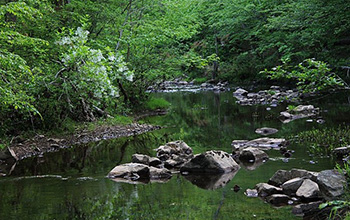Research News
'Fitbits' for streams
Scientists monitoring streams to predict how freshwater vital signs might shift with development, climate change

New Hope Creek, North Carolina, looking west, with blooming fringe tree on the left bank.
March 21, 2022
On one of the first mild days in February, Duke University's Emily Bernhardt and other stream ecologists donned their hip waders and ventured out to the sycamore-lined banks of New Hope Creek. The creek snakes its way through parts of Chapel Hill and Durham before emptying into Jordan Lake, the main drinking water supply for central North Carolina.
Bernhardt waded into the shallow stream and dipped a gas sensor into the water. She and colleagues have been monitoring fluctuations in oxygen and carbon dioxide that occur as these gases are taken up and released by algae, insects, fish and other stream organisms while they go about the business of life: photosynthesizing, growing, digesting and decomposing.
"This 'breathing in and breathing out' of all the organisms living in a river is sort of the 'pulse' of a stream," Bernhardt said. "It's a fundamental measure of the energy going in and out of the system."
Traditionally, such studies have relied on measurements of a small number of streams taken over a few hours or days -- essentially a snapshot. The difficulty is that irregularity and upheaval are the norms for streams, said co-author Phil Savoy.
Streamflow can change from day to day and even minute to minute with seasons and storms. Organisms living in the river must contend with flows that range from a torrent to a trickle. "On any given day you can go down to your local creek, and it might be dry, or it might be flooding over the banks," Savoy said.
Now, thanks to modern sensor technology, scientists can automatically track stream vital signs 24 hours a day, seven days a week, over the course of weeks and months. The data are uploaded to a public web portal where anyone can view or download it. "It's like having your pulse taken once at the doctor's office versus wearing a Fitbit," Bernhardt said.
In a paper published in the journal Proceedings of the National Academy of Sciences, Bernhardt, Savoy and colleagues from nine other institutions analyzed data from 222 rivers across the United States: winding through Arizona deserts, rushing through Puerto Rican rainforests, and meandering through farmland in the Midwest. The research was supported by the U.S. National Science Foundation.
"Advancements in sensors to continuously measure stream metabolism coupled with innovative ways to analyze the data are providing new insights into the complexity and variability of streams and their biota," said Liz Blood, a program director in NSF's Division of Environmental Biology. "In exploring more than 200 streams, the researchers were able to look at the human and environmental factors important in defining stream dynamics."
The sensors recorded dissolved oxygen, carbon dioxide, light and other data every five minutes day and night, through changing seasons, floods and droughts. The hope is that continuous tracking will bring scientists closer to understanding the pulse of streams, and how the ability to support life might change with land development and climate change.
-- NSF Public Affairs, researchnews@nsf.gov




修改评论